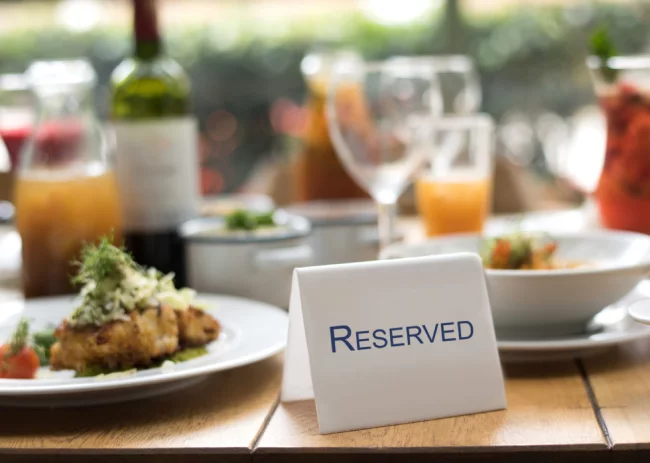In today’s fast-paced digital world, customers expect convenience and efficiency when it comes to dining out. One of the most effective ways to enhance customer experience is by integrating a ‘Book a Table’ feature on your restaurant website. This feature not only streamlines the reservation process but also boosts customer satisfaction and can lead to increased sales. Here are some essential tips for effectively incorporating a ‘Book a Table’ feature on your restaurant website.

Table of Contents
Toggle1. Choose the Right Reservation System
Selecting the right reservation system is the first step in implementing the ‘Book a Table’ feature. Here are some popular options:
- OpenTable: A widely used platform that allows customers to book tables easily and provides restaurants with valuable insights and management tools.
- Resy: Known for its user-friendly interface, Resy offers features like waitlist management and guest profiles.
- Tock: This platform not only allows table bookings but also supports event reservations and ticketing, making it ideal for restaurants with unique dining experiences.
- Custom Solutions: Depending on your needs, you may also consider a custom-built reservation system tailored to your restaurant’s specific requirements.
2. Make It Prominent on Your Website
The visibility of your ‘Book a Table’ feature is crucial for driving reservations. Here’s how to ensure it stands out:
- Use a Clear Call-to-Action: Place a prominent button with an inviting label, such as “Book a Table” or “Reserve Now,” on your homepage and main navigation menu.
- Sticky Header: Consider using a sticky header that keeps the booking button visible as users scroll through your website, making it easily accessible at all times.
- Color and Design: Use contrasting colors and an eye-catching design for the reservation button to grab attention and encourage clicks.
3. Optimize the User Experience
A seamless user experience is key to encouraging customers to complete their bookings. Focus on these elements:
- Simple Booking Form: Keep the reservation form straightforward, asking only for essential information like name, contact number, date, time, and number of guests.
- Real-Time Availability: Ensure that your reservation system shows real-time availability to prevent overbooking and manage customer expectations effectively.
- Mobile Responsiveness: Many customers will book tables using their smartphones, so ensure that your reservation feature is fully optimized for mobile devices.
4. Provide Detailed Information
When customers decide to book a table, they want to know more about your restaurant. Provide detailed information to help them make an informed decision:
- Menu Previews: Include links to your menu or even a PDF version that customers can view before making a reservation.
- Special Offers: Highlight any special promotions, like happy hour or seasonal menus, that could entice customers to book a table.
- Ambiance Descriptions: Share details about the dining experience, such as outdoor seating, private dining options, or themed nights, to create excitement around the visit.
5. Integrate with Other Systems
To streamline operations, consider integrating your booking system with other restaurant management tools:
- POS Systems: Integrating with your Point of Sale (POS) system can help you manage reservations, track customer preferences, and streamline service.
- CRM Tools: Customer Relationship Management (CRM) tools can help you track reservations, send reminders, and maintain customer profiles for personalized service.
- Marketing Platforms: Sync your booking system with email marketing tools to send confirmation emails and follow-up messages, encouraging repeat visits.
6. Offer Flexibility
Flexibility in booking options can enhance the customer experience and encourage reservations:
- Same-Day Reservations: Allow customers to make same-day reservations to accommodate last-minute diners.
- Cancellations and Modifications: Implement an easy process for customers to modify or cancel their reservations online, reducing no-shows and customer frustration.
- Group Reservations: Offer options for larger groups or private dining experiences, catering to special occasions like birthdays or corporate events.
7. Utilize Confirmation and Reminder Notifications
Keeping customers informed is key to ensuring a smooth reservation experience:
- Confirmation Emails: Send immediate confirmation emails upon booking, including details like the reservation time, date, and any special requests.
- Reminder Notifications: Consider sending reminder emails or texts a day before the reservation to reduce no-shows and confirm their plans.
8. Collect Feedback Post-Visit
After the dining experience, gather feedback to improve your service and enhance future reservations:
- Follow-Up Emails: Send a follow-up email thanking customers for their visit and asking for their feedback on the booking experience and their meal.
- Incentives for Feedback: Encourage customers to leave reviews or fill out surveys by offering a discount on their next visit or a chance to win a gift card.
Conclusion
Incorporating a ‘Book a Table’ feature on your restaurant website can significantly enhance the dining experience for your customers while boosting your business efficiency. By choosing the right reservation system, optimizing user experience, providing detailed information, and maintaining effective communication, you can create a seamless booking process that encourages customers to choose your restaurant time and again. Start implementing these tips today, and watch your reservations soar!


No responses yet